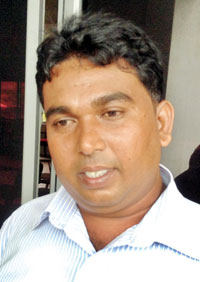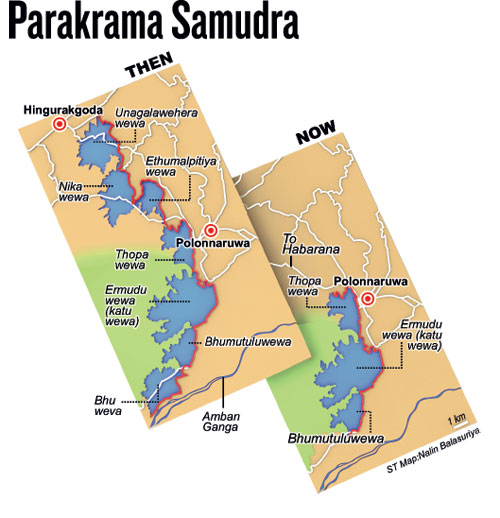Sunday Times 2
Ancient Parakarma Samudraya bund being lost to bricks and roads
View(s):Researcher calls for measures to protect archaeologically important “great reservoir” and artefacts connected to it
By Wasantha Ramanayake

Researcher Indika Manawadu: Awareness campaigns can minimise the destruction to the ancient bund
The ancient Parakrama Samudraya’s bund which lies outside the boundaries of the present tank is being destroyed by villagers without knowing its archaeological value, a study carried out by a young researcher shows.
Indika Manawadu, a self-thought researcher and explorer, whose work has won appreciation from the Archaeologists community, said the ancient bund was found outside the archeological reserve of the ancient city. But it had been destroyed in places such as Bendiweva , Jayawickrama Junction and Unagala Vehera beyond the northern most end of the ancient Samudraya due to lack of proper laws to protect them.
Mr. Manawadu presented his research on the Ancient Parakrama Samudraya, the marvel of Sri Lanka’s early irrigation engineering, at the National Archeology Symposium 2013. It is said that his research rewrote the history of the ancient Samudraya because he proved that the ancient reservoir was nearly thrice the size of the present Parakrma Samudraya. But, much of the area is being used today as paddy fields.
“The villagers encroached on the ancient bund to expand their paddy fields,” Mr. Manawadu said, adding that in many villages, soil from the bund is used for brick-making, road filling and other purposes.
“Houses have come up atop the bund from Bendiwewa to Ethumalpitiya, a nearly one-kilometre long stretch, while in villages such as Bhu Wewa, Kalahagala and Swarnapaligama, soli is removed from the ancient bund to make bricks.”
 He lamented that people hardly understand the archeological value of the ancient bunds. They did not know they were removing parts of the ancient Samudraya. “Some think it is just a bund, an obstacle or a source of soil,” he said stressing the need for campaigns to educate the villagers.
He lamented that people hardly understand the archeological value of the ancient bunds. They did not know they were removing parts of the ancient Samudraya. “Some think it is just a bund, an obstacle or a source of soil,” he said stressing the need for campaigns to educate the villagers.
He said King Parakrama Bahu the great built several pillars with inscriptions on the bunds. The Ethmalpitiya Wewa Pillar inscriptions, which were read and recorded, identified the Ethmalpitiya Wewa as part of the Parakrama Samudraya, but the pillar is now missing. The Nika Wewa Pillar with similar inscriptions was broken into three pieces.
The young researcher, expressing fears that a similar fate was awaiting the Nika Wewa pit valve and sluice, which has been partially damaged by treasure hunters, said the vandalism simply highlighted the urgent need to protect the archaeologically important landmarks before it was too late.
He said thhere should be seven sluices in the Samudraya, according to Mahawamsa, but two were yet to be discovered.
“What I saw 15 years ago was the overgrown tall bund, but today I see a row of houses or some cultivation, or just a flat land. Perhaps, tomorrow I wouldn’t see a bund at all,” he said.
His interpretation
According to Mr. Manawadu, King Parakramabahu called his great work a Samudraya not only because it was by far the largest reservoir ever to have been built by man, but also it had retained water to its full capacity throughout the year, just like a “Samudraya,”as water was not released for agriculture.
“This is his concept of Samudraya as opposed to the traditional concept of “Wapi or Wewa,” which released great amount of water during the dry period for agriculture,” he said.”

Soil being removed from the ancient bund that was part of the great "Samudraya" that King Parakramabahu the Great built. Right: Eramuduwewa section of the present Parakrama Samudraya in the morning
Mr. Manawadu said that English colonial engineers who studied the Parakrama Samudraya were surprised not to find features typical of traditional tanks. Records show that they measured the length of the bund and it was found to be 12.5 km long, too long to be a bund of an ordinary tank. They also looked for the sluices that should be able to take water out from the bottom of the great Samudraya as it was necessary to take maximum amount of water for cultivation during long droughts in dry zone. They did find the sluices but they were built on higher up on bund just to take water out on the spill level. There were no mud sluices either. However, they did not question why. They constructed three new sluices to get water for irrigation when the tank was restored in 1942.
The breach of the bund closer to a place called Eramudu wewa — these were fairly new names used by villagers — in 1958 saw the construction of a new spillway, which had not been originally there, though it was a traditional feature of other ancient tank. However, with renovation, the Samudraya received the typical features of the Anuradhpura-era tanks, which were mainly used for cultivation.
The excavation and restoration went on in the Polonnaruwa ancient city, but it was not clear how much work had been done in respect of the Parakrama Samudraya for decades. According some sources, Martha Pricott Fernando restored the ancient valve pit of the present Buwewa section of the ancient Parakrama Samudraya.
There is hardly any new knowledge, apart from what had already been revealed by the likes of H.C.P. Bell, Senarath Paranavithana and R.L. Brohier. Although it is by far the largest tank built by the ancient kings, it remained a tank just like hundreds of others without much of archeological interest, until Mr. Manawadu dug into its buried history.
Mr. Manawadu developed his concepts of the Parakrama Samudra — or the sea of Parakrama Bahu the Great — after 15 years of research with great courage against the torrents of established beliefs. He challenged the established views that the Great Samudraya was built to make the country self-sufficient in rice and that the country earned the legendary title of the Granary of Asia, as it had exported rice to other countries.
His concept of the Samudraya is that it comprised seven sections which made a 24 km-long massive water body created especially for the defence of the city. The water had been used for city beautification and to raise water bed and for navigation.
To prove his assertion, Mr. Manawadu showed the similarities among the old valve pits and sluices in the present Parakrama Samudraya and that of Bhu Wewa and Nika Wewa. He also pointed out the pillar inscription found in Ethumal Wewa bund which proved that it was part of the same Samudraya.
 He said the Ethumalpitiya portion belonging to the old Samudraya is the only part that still serves as a tank or weva and the rest was paddy fields. Ehumalpitiya is located north of the present Samudraya and had no old sluices. “But there was pillar inscription that proclaimed it is a part of the Samudraya. Unfortunately it was missing,” he lamented. He said that the Ethumalpitiya Wewa was connected to the Samudraya by a canal of less than one kilometre long.
He said the Ethumalpitiya portion belonging to the old Samudraya is the only part that still serves as a tank or weva and the rest was paddy fields. Ehumalpitiya is located north of the present Samudraya and had no old sluices. “But there was pillar inscription that proclaimed it is a part of the Samudraya. Unfortunately it was missing,” he lamented. He said that the Ethumalpitiya Wewa was connected to the Samudraya by a canal of less than one kilometre long.
The next section of the ancient Samudraya was Nika Weva which was proved by the pillar bearing similar royal inscriptions stating that the bund belonged to the Parakrama Samudraya, he said. “Although it was broken into three pieces, this pillar is vital evidence to say that the Nika wewa is also part of the same grand Samudraya. Its ancient sluice was lost to the jungle to be vandalized by treasure hunters. These two ruins are of tremendous evidence to prove that Nika Wewa section also belonged to the great reservoir.”
The Unagalawehera is the northern most section of the reservoir’s ancient bund and it is the most threatened.
| Potential world heritage site The ancient Prakrama Samudraya meets all the requirements to be declared as a world heritage site. The Institute of Tourist Guide Lecturers passed a unanimous resolution to urge the UNESCO to declare the ancient Samudraya as a world heritage site. The institute’s president, Indika Vithanage, said a team had already studied Mr. Manawadu’ research paper and conducted more field research. ” Meanwhile, the Archeology Department is to declare the ancient bunds as monuments in a bid to conserve them. | |

